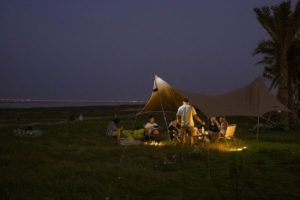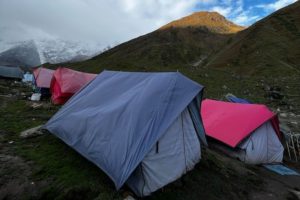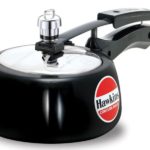When it comes to backpacking, seasoned adventurers always seek innovative gear that enhances their outdoor experiences.

Whether it’s ultralight tents, high-performance backpacks, or efficient cooking systems, backpackers constantly seek ways to optimize their gear choices.
One unconventional option recently gaining traction is using Tyvek as a tarp. Join us as we unravel the possibilities of Tyvek as a backpacking tarp, examining the pros and cons.
What is Tyvek?
Tyvek is a synthetic material known for its unique strength, durability, and lightweight properties.
DuPont developed it, and it is often referred to as a nonwoven fabric or a spun-bonded olefin.
It is made from high-density polyethylene (HDPE) fibers that are randomly laid and then bonded together using heat and pressure, creating a tough and flexible sheet.
Tyvek is a versatile material and is considered a sustainable material due to its recyclability.
It can be easily recycled through programs offered by DuPont, minimizing waste and promoting environmental responsibility.
Advantages of Tyvek as a Tarp for Backpacking
Many people often wonder if Tyvek as a tarp for backpacking is a good idea, and the answer is Yes.
Tyvek offers several advantages as a tarp for backpacking due to its unique properties and characteristics.
Here are five thorough advantages of using Tyvek as a tarp for backpacking:
Lightweight and Compact
One of the primary considerations when backpacking is minimizing weight and optimizing space.
Tyvek excels in this aspect as it is exceptionally lightweight.
Compared to traditional tarp materials like canvas or nylon, Tyvek provides significant weight savings without compromising strength and durability.
It allows backpackers to carry less bulk and enjoy a more comfortable hiking experience.
Weather Resistance
Tyvek is highly resistant to water and wind.
Its nonwoven structure and tight fiber bonding create a reliable barrier against moisture, protecting you and your gear from rain, snow, and other environmental elements.
This weather resistance ensures that you can set up your tarp confidently, knowing it will provide a dry and secure shelter.
Durability
Backpacking often involves encountering rugged terrains, sharp objects, and unpredictable conditions.
Tyvek’s exceptional durability makes it an excellent choice for a tarp. It can withstand abrasions, ensuring it can withstand outdoor adventure challenges.
This durability allows you to rely on your tarp in various environments, including dense forests, rocky areas, or even desert landscapes.
Breathability

Condensation can be a concern when using a tarp as shelter, as it can lead to a damp and uncomfortable sleeping environment.
Tyvek’s unique breathable properties help mitigate this issue. It allows moisture vapor to escape, reducing condensation buildup inside the shelter.
This breathability contributes to a more comfortable and dry sleeping environment, particularly during colder seasons or in high-humidity areas.
UV Resistance
When exposed to sunlight for prolonged periods, some tarp materials may degrade and lose their strength over time.
However, Tyvek is known for its excellent resistance to ultraviolet (UV) radiation. It can withstand prolonged exposure to sunlight without significant deterioration.
This UV resistance ensures that your Tyvek tarp remains robust and dependable even during extended backpacking trips or when camping in sunny environments.
It is particularly advantageous for hikers who embark on long-distance journeys or those who frequently engage in multi-day backpacking adventures.
The ability of Tyvek to maintain its integrity under the sun adds to its longevity and overall performance.
Disadvantages of Tyvek as a Tarp for Backpacking
While Tyvek has several advantages as a tarp for backpacking, it’s important to consider a few potential drawbacks.
Here are three cons associated with using Tyvek as a backpacking tarp:
Limited Size Options
Tyvek is not as widely available in specialized outdoor gear stores compared to other tarp materials.
While it can be purchased online or sourced from construction suppliers, finding Tyvek specifically marketed for outdoor use may require some research and effort.
Additionally, Tyvek rolls or sheets may come in limited size options, and finding the exact dimensions you desire for your tarp might be more challenging compared to materials specifically designed for backpacking.
Lack of Aesthetics
Tyvek’s appearance may not be as visually appealing as other materials commonly used for camping tarps.
Tyvek has a distinct white or light gray color and a paper-like texture, which may not align with the desired aesthetics for some backpackers.
If aesthetics are an important factor for you, Tyvek may not meet your preferences regarding the overall look and feel of your camping gear.
Limited Color Options
Tyvek typically comes in a white or light gray color, which may not be ideal for stealth camping or situations where you want to remain inconspicuous in natural environments.
The bright color of Tyvek can stand out in certain landscapes, potentially drawing attention to your camping location.
If stealth camping or blending in with the surroundings is a priority for you, the limited color options of Tyvek may be a disadvantage.
Initial Rigidity and Noise
When brand new, Tyvek can be relatively stiff and noisy, particularly when it rubs against itself or other objects.
This stiffness makes it more challenging to fold and pack the tarp than more pliable materials.
Additionally, during windy conditions, the stiffness of Tyvek can cause flapping noises, which some backpackers may find disruptive and potentially affect their sleep quality.
However, with use and time, Tyvek tends to soften and become less noisy.
It’s worth noting that while these cons exist, many backpackers still find the advantages of Tyvek outweigh these drawbacks.
It ultimately comes down to personal preferences and priorities when selecting the most suitable tarp material for backpacking.
How to Choose the Right Tyvek Tarp

When choosing the right tyvek, here are a few things to consider:
Consider Tarp Size
Tyvek tarps come in various sizes, so it’s essential to select the appropriate dimensions based on your specific requirements.
Therefore, consider the area you need to cover, keeping in mind that it’s generally better to have a slightly larger tarp than one that’s too small.
Likewise, measure the space accurately to ensure a proper fit and maximum coverage.
Weight and Thickness
The weight and thickness of a Tyvek tarp can vary, and this choice depends on your specific requirements.
A heavier tarp generally offers increased durability and resistance to wear and tear. However, it may be bulkier and less portable.
Lighter options are easier to handle and carry but may be less rugged.
Consider the trade-off between weight and durability based on your intended use and transportation needs.
Grommets and Attachment Points
The presence of reinforced edges and grommets significantly enhances the tarp’s usability.
Grommets are vital in securely attaching the tarp and preventing it from flapping or coming loose.
Check for the presence of reinforced grommets along the edges or corners of the tarp.
Ensure they are evenly spaced and made of durable materials, such as metal or heavy-duty plastic.
Also, make sure to check the quality and distribution of grommets to ensure they are sufficient for your intended use.
Evaluate Weight and Thickness
Tyvek tarps come in different weights and thicknesses, denoted by the measurements of grams per square meter (gsm).
However, heavier tarps generally offer increased durability but might be bulkier and less portable.
On the other hand, lighter options are easier to handle but may sacrifice some toughness.
As such, it is necessary to strike a balance between weight and durability based on your needs.
Takeaway
After examining the various aspects of using Tyvek as a tarp for backpacking, it is evident that it can be a good idea under certain circumstances.
However, the decision to use Tyvek as a tarp will depend on your individual preferences, specific backpacking conditions, and the trade-offs you are willing to make.
It can be a practical and efficient choice for some backpackers, while others may prefer other options.
Therefore, assess your priorities and requirements, and make an informed decision that aligns with your backpacking goals and preferences.

When I was in high school, I was the best at running. Running for me is not a trend, this is my whole life. I jog every morning, without exceptions: I don’t skip mornings on vacations or business trips. My friends are also sports fans: I went to my best friend’s yoga class for the first time about three years ago.
Since then, I’ve been practicing regularly, and we have also made several yoga trips to India. For my last birthday, I got a skateboard as a present from her. Now we’re both taking personal classes with a coach, and it’s 100% fun!





